Cabinets Deliver Clever Storage and Style
What are the hot trends in cabinetry this season? Where is it being used in new ways? What materials and finishes are you specifying? What hardware, features, configurations and technology are trending among your clients and in your region? Do you anticipate these trends continuing into the new year? Inquiring minds want to know! So here are the latest takes from across the country and industry:
- National homebuilder Taylor Morrison’s National Design Director Lee Crowder;
- Marine Sargsyan, with online home products giant Houzz.com;
- National Kitchen & Bath Association’s Pamela McNally;
- Philadelphia area designer Liz Walton;
- Designer Shannon Ggem in Los Angeles;
- Minneapolis-based designer Lisa Peck.
OVERVIEW
It’s no secret that our industry is booming, with strong consumer demand and ongoing shortages of skilled labor and products. Nonetheless, homeowners are still seeking to improve their spaces. Despite the challenges, everyone is surging forward and cabinetry has a significant slice of that activity.
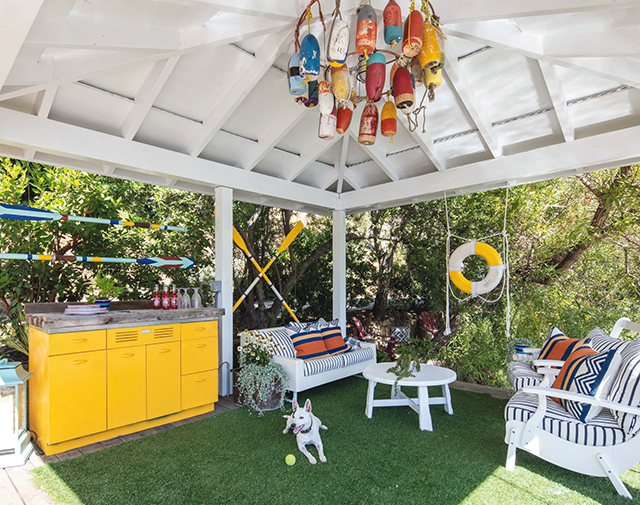
Eye-popping color and outdoor cabinetry are both trending.
Photo: Shannon Ggem, Ggem Design // Mike P. Kelley (Photographer)
“Incorporating storage was an important aspect of homeowner’s renovation activities in 2020,” Sargsyan reports. Houzz’s 2021 study found that nearly one in five homeowners cited inadequate storage for enlarging their kitchens, she notes, and “More than half of all kitchen renovations included new cabinetry (57 percent).” Smaller kitchens included even a higher percent of cabinetry replacement (63 percent).
“Storage is one of the top three areas of consumer interest,” McNally agrees, noting that, “Reducing clutter, better organization, easy access all are driving this shift.” Some of this growth can definitely be attributed to the pandemic, especially as homeowners sought to reduce their shopping trips.
Hot Spots: “The pantry is becoming a very trendy place in the home to not only organize but maximize your storage, especially as bulk buying became more popular this past year,” declares Crowder. She notes the popularity of food storage organization. “It obviously starts with a great pantry.” Houzz also saw a surge in pantry upgrades, with nearly half of study respondents improving their cabinetry, an increase over 2020.
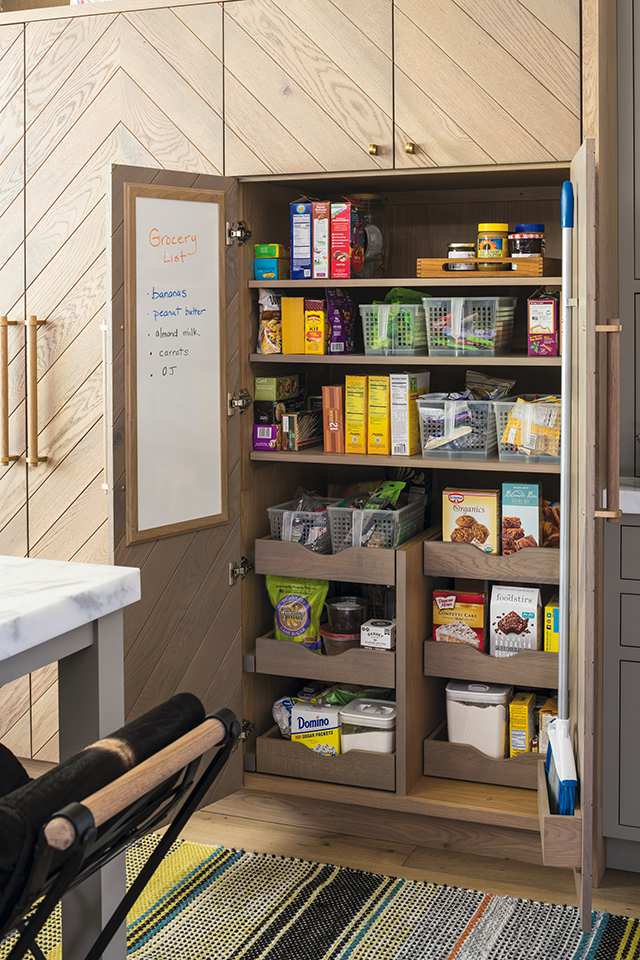 Flex rooms are definitely trending with new cabinetry needs. This includes laundry, pet and craft spaces. They’re also popular spots for bulk buying storage to enhance pantry capacity.
Flex rooms are definitely trending with new cabinetry needs. This includes laundry, pet and craft spaces. They’re also popular spots for bulk buying storage to enhance pantry capacity.
Home offices, garages and outdoor spaces have become hot spots for new cabinetry designs, too, because of the pandemic. Working from home, exercising, storing overflow items and escaping safely outdoors are all COVID-19-driven accelerations. “Many of our floor plans offer a mud locker or drop zone built in,” Crowder observes, “The more time you spend at home, you realize how important having a built-in space for those daily essential items at the entrance (usually from the garage) gives you peace of mind and [helps] everyone find what they need when it’s time to leave the house.”
Technology Trends: Smart home features are making their way into cabinetry as well. “Kitchens, baths and entire residential environments have been embracing fully integrated technology, and storage is a key area,” McNally says. The goals include accessibility, better visibility and security, the NKBA executive observes. “Smart home sensors help facilitate leak detection, temperature and lighting controls and are being designed into pantry areas, lower cabinets, shower enclosures, under sink drawers and under cabinets in kitchens. LED lighting is now a standard in virtually all cabinetry installs,” she reports, and the designers agree. Chargers are also being built into cabinetry to reduce clutter.
KITCHEN STORAGE TRENDS
The heart of the home has definitely gotten some transplant improvements. With pantries taking on more importance, sometimes beyond the kitchen, these areas are being freed up to serve more comfort roles.
Specialized Zones: NKBA’s study sees separate spaces for wine and coffee usage. Houzz sees dedicated areas for baking, snacks and beverages and homework. Among the specialty spots, pantries and wine bar storage have the greatest resonance in NKBA’s study. Kitchens are catering to personal preference and specialized zoning.
“We love to include coffee and wine stations with all the associated storage laid out for clients, like a mug drawer and fridge drawer for cream if they use it, or a pod drawer and a nearby wine fridge for bottles not yet being dispensed by the wine dispenser,” shares designer Ggem. Peck is seeing smoothie stations become a trend, along with coffee and beverage centers, and Walton says just about all of her kitchen projects have coffee/breakfast bars.
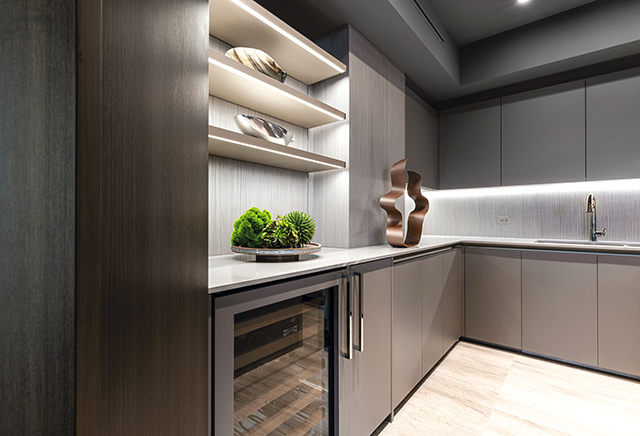
Comfort zones like wine and coffee centers are trending.
Photo: Eolo Design / NKBA
Configurations: “Our clients no longer want upper cabinets, preferring instead deep drawers with peg systems for plate and glass storage,” Ggem notes. Open shelves are still popular but used sparingly, as homeowners realize the dusting required to keep their contents clean, Walton points out. Peck sees narrow pullouts, as well as the general lack of wall cabinets and well-equipped bases and pantries. NKBA’s study cites large pull-out drawers with dividers.
Peck also sees an increase in secondary kitchen spaces, both as “back areas” for cleaning and storage, and auxiliary for older relatives to live independently with the family.
Styles and Finishes: Houzz has Shaker as the most popular style (57 percent), flat panel/slab at 21 percent and raised panel at 17 percent. In terms of finishes for the kitchen, Walton declares, “Wood tones are coming back in a big way! We are seeing a lot of warm walnut islands paired with soft white perimeter cabinets. Painted wood cabinets especially in navy or a powdery blue are very popular and pair well with white and warm wood tones.”
“Self-expression through color in cabinetry is definitely a trend,” Peck says. “We have done orange, yellow, blue and teal cabinetry in the spirit of this trend. We are also seeing a return to mixing painted cabinetry with wood. Rift cut white oak is a strong contender here in the Midwest. In modern kitchens we are seeing the use of acrylic slab door panels in gloss and ultra-matte finishes,” she adds.
Across the country, L.A. designer Ggem is seeing matte finishes and wood, including textured, fluted panels trending in materials. Taylor Morrison’s Crowder is seeing earthy hues along with warm neutrals and NKBA finds ash and rift cut oak solids and veneers trending, along with sophisticated high-pressure laminates.
One final note on finishes: “Wellness is huge in the kitchen conversation. Toxins and off gassing are no longer tolerated, and all clients inquire,” proclaims Ggem.
BATHROOM STORAGE TRENDS
The bathroom has also gotten enhancements. “Just like in kitchens, many people are having electrical outlets and charging stations built into their cabinets,” reports Taylor Morrison’s Crowder. “Another technology item popping up is cold storage,” she observes. “Adding a mini fridge into your cabinet bank allows you to store beauty items that require being cold – but they can also help keep creamers cold so you can make your coffee while getting ready in the bathroom.”
Configurations: Built-in vanities far outstripped freestanding in popularity, with floating styles trending upward, Houzz reports. “The floating vanity helps create visual space, making the vanity feel less heavy within the space,” Walton suggests.
Peck is seeing appliance garages migrate to her midwestern bathrooms, she says. They include chargers for hygiene and grooming tools and magnifying mirrors. She’s also seeing an emphasis on accessible cabinetry and nontoxic materials.
Taylor Morrison homebuyers like open shelves in their bathrooms, Crowder shares. They also want auto-opening and closing doors, outlets and charging stations.
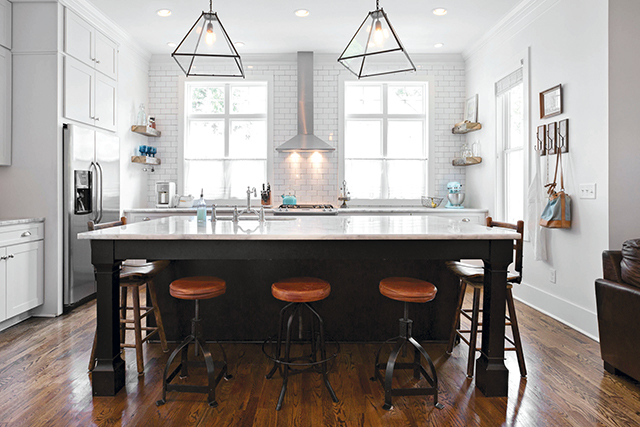
Shaker is still a leading style trend for kitchens and bathrooms alike.
Photo: Caroline Sharpnack © Houzz
Styles and Finishes: Bathroom style trends track pretty close to kitchen, with Shaker, slab and raised panel in similar proportions. Walton sees natural wood tones like white oak and warm walnuts mixed with white or dark gray. Taylor Morrison is seeing light washed warm wood tones and textured woods in low maintenance matte finishes. The builder is also seeing painted looks, especially dark green, trending. Peck is seeing personalized colors, like teal and blues, along with rift cut woods, especially oak and walnut topping trends. Ggem sums up her clients’ preferences this way: “A minimal aesthetic is what is happening right now – slab doors, hidden pulls, quiet and clean.”
LAST WORDS
If your business is based on cabinetry manufacturing, distribution, installation or sales, this should be a strong season for you. It can also be a strong season for those who are “cabinetry adjacent,” like technology providers with a growing area of opportunity. Knowing and predicting the latest trends is essential to staying successful and a candy land full of fun and flair. 
Jamie Gold, CKD, CAPS, MCCWC is an author, wellness design consultant and industry speaker. Her third book, Wellness by Design (Simon & Schuster), published September 2020. You can learn more about her Wellness Market presentations, books, Wellness Wednesdays Clubhouse conversations and consulting services at jamiegold.net.
The post Cabinets Deliver Clever Storage and Style appeared first on Kitchen & Bath Design News.
Did you miss our previous article…
https://www.culturekitchen.net/?p=462
Adapting in a Changing Business Climate
Under normal circumstances, part of our job is to prepare plans for our clients to prime them for changes to their homes and lifestyles. Unfortunately, the pandemic crumbled remodeling hopes for many homeowners, and it had a serious effect on us as designers. First, we went from comfortably busy to zero in about two months. Then we were stagnant for almost a year. That dormancy was followed by a mind-boggling recovery, one that Eliot Sefrin, editor emeritus of KBDN, referred to as a “tectonic market shift.”
I survived the 2007-2009 recession and decided not to give in to the same negative feelings that plagued me until 2010. Instead, I used the pandemic downtime to work on my business, taking classes that had been on my bucket list for five years or more. At the same time, I read over 75 marketing books and white papers. It was not as gratifying as working with clients, but it was a major accomplishment.
Building, maintaining and marketing a unique brand reputation is challenging. There are excellent books and many courses to help us, but your choices need to be carefully considered. I learned the hard way during the recession and ended up wasting time and money on courses that didn’t work. During the pandemic, I avoided repeating the same mistakes.
Two exciting possibilities arose from free webinars recommended by acquaintances. Each marketing coach offered a new direction that sounded promising. One program is $3,500 and requires a commitment of at least six months. The other course costs over $10,000 and involves a year of classes. It’s easy to say “yes” to the compelling reasons the coaches present until we stop to think about our ROI. Curiosity helped me gain clarity to say “No” to the programs. Finally, I said “yes” to another customizable opportunity with great ROI possibilities.
NAVIGATING THE NEW NORMAL
Everyone is now adjusting to a new normal: higher remodeling investments and lower availability of labor and products. Homeowners are anxious to proceed with pandemic-delayed remodeling projects. Our 15-month business famine has become an overflowing feast.
In fact, home remodeling queries on Google went from 38% in March 2020 to 93% in March 2021. The annual Houzz survey verifies that home renovation spending increased 15% in the past year.
But will the trend continue or collapse?
Many variables will affect remodeling in the future, and all we can do as designers is perform our best every day, and stay on top of news reports about the economy, the pandemic and other fluid trends. Being prepared for change helps us cope with it. We can choose our course and correct it before a crisis happens by adapting to change.
The Harvard Business Review offered six tips about adapting to change: 1. Find humor in the situation; 2. Resist talking about your feelings; 3. Don’t stress out about stressing out; 4. Focus on your values instead of your fears; 5. Accept the past (and present) but fight for the future, and 6. Don’t expect stability.
COMPETING AND COMPARING
Competition is as fierce as ever in the design market, with more people entering our profession yearly. For example, 4,199 U.S. students graduated with interior design degrees in 2019. At that time, there were 77,900 interior designers in the nation. The average age of designers is 41 years. We’re all competing to build and maintain our brand reputation, make a living and grow our company (or the company that employs us).
I believe we do better when we compete against ourselves rather than competing against other people. Additionally, we do better when we don’t compare ourselves to others. But, admittedly, this is hard to do in today’s competitive world.
When I was attending design school, every assignment was necessary. I gave each one 115% of my effort, although I believed that others would receive a better grade. I wasn’t competing with them for a grade but rather comparing myself to them.
Before graduation, the faculty and students voted for one student to win the “Student Designer of the Year” award. I was shocked to win because, in my mind, everyone was more qualified than me. The woman who presented the award gave me fantastic advice: “Send press releases to the media.” That established my brand and my reputation, and it attracted clients and referral clients for years.
I continue to give at least 115% to everything I do. Clients’ goals become my goals. I’ve been fortunate to win design awards with this attitude. And while I don’t like to compare myself to other designers, it’s unavoidable. Marketing tools such as SEMRush, UberSuggest, BuzzFeed and Google Analytics provide helpful feedback by comparing me to competitors. It’s uncomfortable but necessary to gather and use this information that mainly relies on keywords we use. But, it’s just as important to not make it the focus of your work. We are each unique, and that should be celebrated!
GAINING THE EDGE
Prospective clients find us using specific keywords or phrases in Google, Bing or Yahoo. Search engines recommend us because we’ve used the same keywords or phrases in our websites, blogs and social media posts. Learning to use the right keywords is an art and a science. It challenges us to comply with specific secretive algorithms. Even Search Engine Optimization experts admit little knowledge about the data. Climbing to #1 of organic searches involves an investment of time and effort.
SEO is a broad subject that I’m still studying, a motivation to revise and write blogs with competitive terms. If your company can afford an SEO specialist, their fee will be $75-$150 per hour, which could add up to $1,500 a month (or more). You can also get monthly SEO services from companies like Fiverr for $14-$345 a month.
How do you know that you’re getting what you want?
Honestly, SEO isn’t a quick process and success isn’t guaranteed. Changes we make now may not show up in search engine results for four to six weeks or longer. To compete effectively, we have to know what keywords our competitors are using to help their ranking in the search engines. Finally, we have to compare ourselves to others who have: A well-known brand, an active website, an up-to-date blog and an active social media presence with good SEO use.
Competing with and comparing ourselves to others in our profession may be uncomfortable, but it’s necessary to adapt if we want to succeed. One of my favorite quotes rings true: “Success requires the ability to adapt. Only by being open to change will you have a true opportunity to get the most from your talent.” [Nolan Ryan] 
Diane Plesset, CMKBD, CAPS, NCIDQ is the principal of D.P. Design in Oregon City, OR and has over 35 years of experience as a kitchen and bath designer. She is the author of the award-winning book, THE Survival Guide: Home Remodeling, and has been the recipient of numerous design awards. Named a 2019 KBDN Innovator, Plesset has taught Western design to students of the Machida Academy in Japan and has a podcast, “Today’s Home.”
The post Adapting in a Changing Business Climate appeared first on Kitchen & Bath Design News.
Kitchen Displays Fresh, Transitional Style
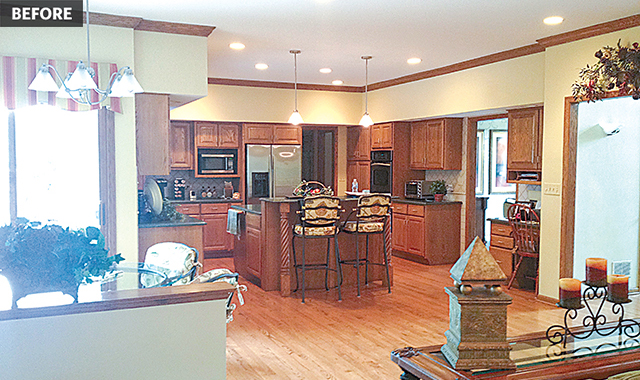 Before
Before
Designer Kelly Guinaugh of Interior Enhancement Group was enlisted for the task of updating a couple’s suburban Chicago kitchen shortly after completing a new kitchen for the same clients in their Florida home. The clients wanted a kitchen that would feel as airy and spacious as their vacation home, with improved workability, increased storage and better traffic flow.
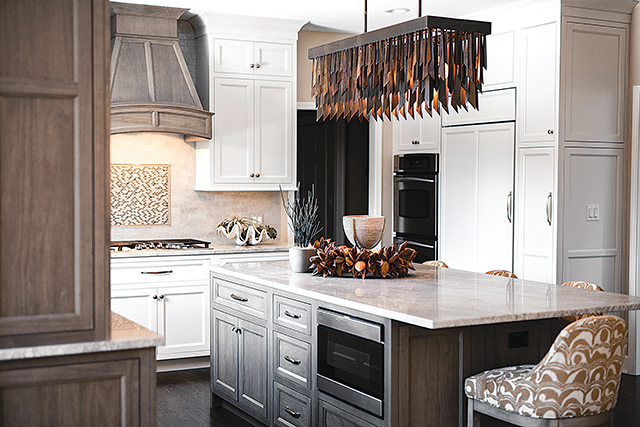 After
After
By widening the entryway from the kitchen to the dining room, Guinaugh was able to create a feeling of spaciousness in the 350-sq.-ft. kitchen. New full-height pantries and cabinetry, as well as a wine cellar, were installed in order to provide plenty of storage. Increasing the width and height of the window over the sink also provided plenty of natural light to make the room feel open and fresh, while removing all soffits and installing taller upper cabinetry created the illusion of higher ceilings. A new, narrower island provides improved traffic flow and facilitates entertaining, and also features increased seating facing the scenic back yard. The end result: a fresh transitional space that flows well into the dining room and great room.
The post Kitchen Displays Fresh, Transitional Style appeared first on Kitchen & Bath Design News.
Did you miss our previous article…
https://www.culturekitchen.net/?p=455
What Story Are Your Financials Telling?
I have always had a burning desire to know how my business measured up to industry peers. Were we above average, middle of the pack or a bottom feeder?
Years ago, while moderating a workshop at KBIS, the workshop presenter invited me to join an industry-specific peer group that he was facilitating. Sensing this is where I could gain some perspective about my business, I accepted the invitation.
My first meeting had me sitting around a boardroom table with owners of eight other kitchen and bath businesses from different geographical areas. The format was simple: sharing information, issues and challenges, and poring over each other’s financial statements.
I arrived at this meeting confident, perhaps even a bit cocky; I knew my numbers. The feeling didn’t last. My peers were starting to ask rapid-fire questions about the financials. I found myself struggling to provide satisfactory answers. Embarrassment and insecurity quickly replaced confidence.
That experience taught me several things. Primarily, I need to spend more time with the financials to understand the relationship between the numbers and the information revealed, and that most kitchen and bath dealers/owners don’t fully understand the importance of their financial statements. The latter is because most have grown up on the design and selling side of the business.
As a business owner, it’s critical to comprehend and own the financial side of the business; otherwise, you may never realize the company’s full income and profit potential. While accountants and bookkeepers play an essential role, it’s the role of owners to learn the meaning of these financial statements and determine what should be done to improve company performance.
So, a little primary education in this arena will set the stage for understanding the crucial values derived from knowing what your financial statements are saying about the state of your business.
The Difference in Financial Statements
Financial statements are divided into three categories: Income Statement (also known as a Profit and Loss Statement), Balance Sheet and a Cash Flow Statement.
An Income Statement measures your company’s financial performance in the current year. It’s measured by how much revenue (sales) has been recorded versus how many expenses have been incurred to generate that revenue level; the difference – revenue minus expenses – is called Net Profit.
A Balance Sheet measures your company’s cumulative performance since the inception of the business. It’s measured by how many assets you have acquired over these years minus the liabilities incurred in the process; the difference (Assets – Liabilities) is called Net Worth. The net worth is derived from several components: initial capital, retained earnings and the current year’s net profit, which is the common link between the Income Statement and the Balance Sheet in any given year.
Cash Flow Statements provide a summary of how cash enters and leaves the company. It measures how well a business manages its cash. Cash is king. Cash is the lifeblood of any business, and how well it’s being managed needs to be documented.
Cash and Accrual Accounting
There is a significant difference between cash and accrual accounting, and not knowing the difference and its impact on a business can lead to severe consequences. The main difference between the two types of accounting is when revenue and expenses are recognized and recorded.
Cash Accounting records revenue when cash is received. A 50% down payment on a newly signed kitchen would show up as revenue on the income statement. With no expenses to record yet, the financials could reveal a sizable net profit. The pitfall for this kind of accounting is that it might overstate the health of the business. Under this scenario, the company could be cash-rich, lulling the owner into a false illusion that the business is profitable when in reality, the business may be losing money.
Accrual Accounting recognizes and records revenue when it is earned. Revenue recognized upon delivery of a product or service aligns with the associated expenses and services provided.
The accrual method provides a more accurate picture of the business’s overall health by including all revenue when earned and all expenses when incurred. This more accurate financial data places an owner in a better position to make sound business decisions and limits the risk of overpaying taxes.
Managing by Percentages
Managing a business by reviewing and looking at strictly numbers can be challenging. It can be easy to overlook a change in revenue or an increase in expenses when focused primarily on the numbers – or, worse, not knowing what the numbers mean. It also makes it difficult to compare one financial statement to another or understand the changes occurring over time.
A more straightforward method to manage is inserting a column into a financial statement where any line item amount is expressed as a percentage of the overall net revenue. Total revenue is listed as 100%, and cost of goods, gross profit and all other line items are expressed as a percent of the total revenue. This method makes it easier to analyze the performance of a business over time and compare it with peers or industry benchmarks.
Benefits of Knowing Your Financials
Your financials tell a story about your business, what is occurring at the moment, and a telling tale about your organization’s history. It’s important to be adept in reading, interpreting and using your financial statements as a guide to making wise business decisions.
There are many benefits to being financially savvy. First, you can protect yourself from possible embezzlement. Placing all your trust in a bookkeeper without having financial know-how creates exposure that is often hard to overcome.
Second, you can better measure your financial performance against others in a group, identifying weaknesses where your business can improve. Third, you can ask better questions of professionals so you can secure better advice. Fourth, you can set more intelligent and realistic goals. Fifth, you can furnish more confident leadership, attracting and retaining quality personnel. And sixth, knowing the financials like you know the designing of kitchens can make you a lot more profit!
Commit to gain a deeper financial understanding of your business. Invest in yourself to learn the financials, and the story conveyed. Financial knowledge comes with reward – realizing the full profit potential of the business and leveraging it appropriately. 
Dan Luck owns Bella Domicile in Madison, WI. He has been an SEN Member since 2002 and has led the SEN Leadership Team since 2018. Visit sendesigngroup/education for more information. Dan welcomes
questions and comments at [email protected].
The post What Story Are Your Financials Telling? appeared first on Kitchen & Bath Design News.
Did you miss our previous article…
https://www.culturekitchen.net/?p=452